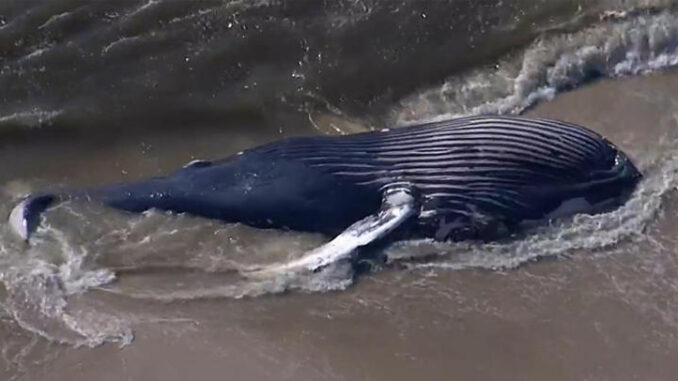
Saying protective distances adopted by the National Marine Fisheries Service for incidental harassment authorizations related to offshore wind sonar work is having the opposite effect, Save the Right Whales Coalition wants the federal government to take emergency action to halt the work.
NOAA Fisheries issues permits for “incidental harassment” of whales and dolphins when it authorizes seabed surveying using high-intensity noise devices.
“Our data shows that the sonar is producing Level B harassment noise levels at distances that exceed those set by NOAA Fisheries,” Lisa Linowes, co-founder of Save the Right Whales Coalition, wrote in a Sept. 8 letter to Richard Spinrad, NOAA administrator and undersecretary of commerce for oceans and atmosphere. “Marine mammals are likely getting much closer to the sonar than should be allowed.”
IMPACT: (From left) David Shanker of the New Jersey for Save the Whales Coalition and Bob Stern, president of Save LBI, toured offshore wind lease areas earlier this month. (Supplied Photo)
Save the Right Whales Coalition, an alliance of environmental groups, scientists and conservationists, believes the sound/distance ratio plays a major role in whale deaths in the Atlantic Ocean dating back to December 2022 and the unusual mortality events dating back to 2017-18.
“The only mitigation for noise is distance. The shortened Level B distances enforced under the IHAs have, in effect, rendered any expected mitigations useless,” Linowes wrote.
Save the Right Whales Coalition said more than 70 dead whales have washed ashore, and more than 370 cetaceans, including dolphins and porpoises, have either washed ashore or been sighted decaying in the water since December.
In the same time frame, NOAA Fisheries has reported the death of two North Atlantic right whales, one in Virginia and the other in North Carolina. There have been four documented entanglement cases, including two in North Carolina and one each in Massachusetts and Georgia. A repeat sighting of an entangled North Atlantic right whale off Cape May was also documented this year, as was the significant health decline of “Specs,” an adult North Atlantic right whale male first sighted in 1999, according to NOAA Fisheries.
NOAA declared an unusual mortality event in 2017 for the marine mammals. Since then, it has reported 36 dead North Atlantic right whales, 34 seriously injured and 45 sublethal injured or ill.
The North Atlantic right whale has been on the endangered list for more than five decades, and there are currently only an estimated 350 North Atlantic right whales remaining, with fewer than 70 breeding females, according to NOAA.
“In light of the recent industry-related issues wind developers are facing and the negative impacts we are already seeing along the East Coast, in correlation to surveying activity, we demand a moratorium for offshore wind turbine developments,” said David Shanker, New Jersey spokesperson for Save the Right Whales Coalition. “We are at a pivotal moment in this fight. This is not the time for New Jersey or the East Coast to be used as an experiment with no hard evidence of the substantial and long-lasting effects these projects will have.”
His comments follow a boat tour earlier this month that focused on the study of impacts offshore wind development will have on the Jersey Shore’s ecosystem, including marine mammals, commercial and recreational fishing, shore communities, boating safety and national security interests. Bob Stern, president of Save LBI, was also aboard for the trip, which included Meghan Lapp, secretary for the center for sustainable fisheries; Bonnie Brady, executive director of Long Island Commercial Fishing Association; and Trisha DeVoe, founder of Save Our Whales Now and a conservation biologist.
In May, Robert Rand, a leading echo sound expert, detected high-decibel sonar approximately 43 nautical miles east of Barnegat Light that did not match the equipment cited in the incidental take permit, prompting a comprehensive look at additional expired and active IHAs, Linowes said.
Those reviews “revealed a regular pattern of NMFS accepting Level B harassment distances that are well under those expected,” she wrote, adding, “Inadequate mitigations during a sonar survey could result in marine mammals experiencing sound levels that may injure or kill. The record suggests that NMFS has not conducted independent monitoring of the active sonar surveys in the field.”
Instead, it appears the federal agency has accepted and enforced claims by the permitted applicants regarding sparker levels, without requiring the authentication of the actual levels, according to Linowes’ letter.
“NMFS has repeatedly claimed to the public that sufficient protective mitigations are in place when, in fact, the mitigations against Level B harassment (and potentially Level A impacts) imposed on applicants are not meaningful,” she wrote, adding, “We note that U.S. Coast Guard data show roughly 15 separate sonar vessels are currently active within the New York and New Jersey wind lease areas and each vessel may be producing sound levels that far exceed NMFS’s threshold standards for protecting marine life.”
— Gina G. Scala
ENB Top News
ENB
Energy Dashboard
ENB Podcast
ENB Substack

